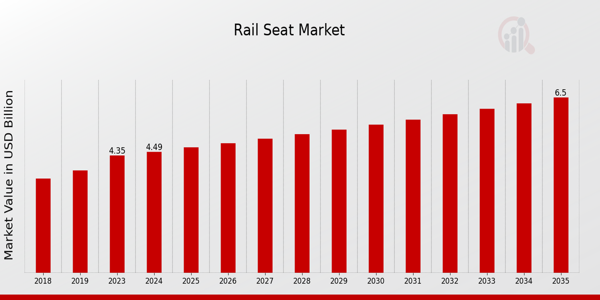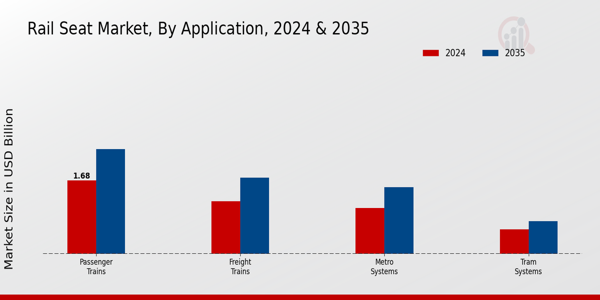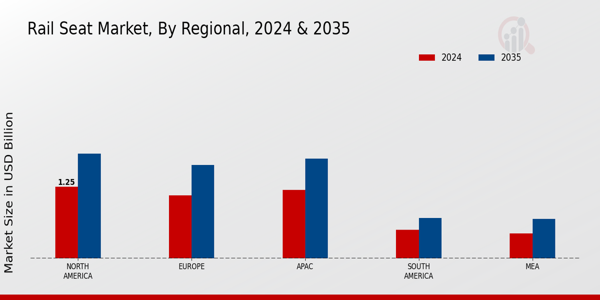Global Rail Seat Market Overview
As per MRFR analysis, the Rail Seat Market Size was estimated at 4.35 (USD Billion) in 2023. The Rail Seat Market is expected to grow from 4.49 (USD Billion) in 2024 to 6.5 (USD Billion) by 2035. The Rail Seat Market CAGR (growth rate) is expected to be around 3.41% during the forecast period (2025 - 2035).
Key Rail Seat Market Trends Highlighted
A number of important reasons are driving the Rail Seat Market. There is a growing need for premium seating options as a result of the expansion of rail infrastructure projects in different areas. Rail operators are upgrading their seating arrangements in response to increased passenger comfort and safety.
While the emphasis on sustainability is driving the market toward eco-friendly seating alternatives, innovations in materials and design are meeting the changing needs of travelers.
Additionally, pledges to upgrade metropolitan public transportation networks play a big role in industry growth. One of the market's opportunities is the possibility of seating solutions that can be customized.
Rail operators are seeking unique designs that reflect their branding while optimizing space and comfort. The integration of smart technologies offers further avenues for development, such as adjustable seats and built-in power outlets, appealing to tech-savvy passengers.
Furthermore, as rail transport aims for a more significant share of the overall transport sector, collaborating with manufacturers to create innovative seating can lead to competitive advantages.
Recent times have seen trends toward modular seating arrangements, which allow for easier maintenance and upgrades. Moreover, there's a growing emphasis on the use of lightweight materials to enhance energy efficiency in trains.
The rise of high-speed rail projects has also influenced designs, necessitating the creation of seats that can withstand higher speeds while providing comfort. Enhanced safety features, such as better crash protection and fire-retardant materials, are becoming more standard.
As consumer expectations evolve, the focus on ergonomics and aesthetic appeal becomes vital for attracting travelers. The combination of these elements illustrates the dynamic nature of the Rail Seat Market and its response to changing transportation needs.

Source: Primary Research, Secondary Research, MRFR Database and Analyst Review
Rail Seat Market Drivers
Increasing Demand for Comfortable and Ergonomic Seating Solutions
The Rail Seat Market is experiencing a significant shift in consumer preferences towards comfortable and ergonomic seating solutions. With the rising focus on enhancing passenger experience during rail travel, manufacturers are investing in innovative designs that prioritize comfort and support.
Comfort-driven seating not only improves passenger satisfaction but also contributes to longer journeys, accommodating various demographics, including families, elderly travelers, and long-distance commuters.
Additionally, ergonomic seating promotes better posture, thereby reducing the likelihood of discomfort or health issues associated with extended periods of sitting. Moreover, many rail operators are actively pursuing upgrades to existing seating arrangements or introducing new models that highlight these comfort features.
This evolving preference for premium seating options reflects broader trends in customer service and quality, driving growth in the Rail Seat Market. As more people return to rail travel post-pandemic, the demand for enhanced seat comfort will likely continue to rise, reinforcing the importance of investing in high-quality rail seat products.
Expansion of High-Speed Rail Networks
The Rail Seat Market is significantly influenced by the ongoing expansion of high-speed rail networks across various regions. Countries and cities are increasingly recognizing the benefits of fast rail systems for both passenger transport and economic development.
These initiatives not only reduce travel times but also promote tourism and business opportunities. As high-speed rail networks continue to grow, the demand for specialized seating that meets the unique needs of high-speed trains is on the rise.
Manufacturers are adapting to these requirements by designing seats that can withstand higher speeds while ensuring passenger comfort. This trend is expected to further stimulate the Rail Seat Market as more rail operators seek to enhance their offerings to compete with air travel.
Adoption of Smart Technologies in Rail Seating
The integration of smart technologies into rail seating solutions is becoming a key driver in the Rail Seat Market. Modern seat designs incorporate advanced features such as adjustable seating, temperature control, and integrated charging ports for personal devices.
This technological evolution not only enhances passenger convenience but also aligns with the growing expectations of tech-savvy consumers. Rail operators are increasingly investing in these innovative solutions to create a more enjoyable travel experience.
The adoption of smart technologies is likely to elevate the standard for rail seating, prompting further demand in the market.
Rail Seat Market Segment Insights
Rail Seat Market Application Insights
The Rail Seat Market focuses on various applications that cater to different types of rail systems, with significant revenue contributions expected from each segment. In 2024, the Passenger Trains application led the way, boasting a valuation of 1.68 USD Billion.
By 2035, this segment is projected to grow to 2.39 USD Billion, highlighting the growing emphasis on passenger comfort and safety in train travel. This segment dominated the market due to the increasing passenger traffic and the demand for enhanced amenities in train services, driving the need for quality rail seats.
Furthermore, the Freight Trains segment held a considerable portion of the market as well; with a valuation of 1.20 USD Billion in 2024, it is expected to rise to 1.74 USD Billion by 2035. This growth is largely attributed to the expanding logistics and transportation sectors, where efficient rail transport is becoming increasingly essential.
The Metro Systems application also played a vital role in the Rail Seat Market, having an estimated value of 1.05 USD Billion in 2024 and projected to grow to 1.52 USD Billion by 2035. Rapid urbanization and the rising need for efficient public transportation in metropolitan areas significantly drove this segment.
The demand for reliable seating solutions in metro systems is critical as these systems cater to high-capacity ridership, requiring durable and ergonomic rail seat designs to enhance commuter experience.
Additionally, the Tram Systems segment, while relatively smaller, still held importance, valued at 0.56 USD Billion in 2024 and expected to reach 0.75 USD Billion by 2035. This segment primarily served urban transit needs and contributes to the overall Rail Seat Market revenue, underlining the significance of trams in smoother city transit.
Overall, the diverse applications of rail seats highlighted the growing adaptability and flexibility of seating solutions in meeting the specific demands of each segment. The majority of the market share is influenced by heightened investments in rail infrastructure, increased urbanization, and the expansion of public transport systems across both developed and emerging economies.
As trends in sustainability and smart transportation evolve, opportunities for innovation in rail seat designs will likely emerge, contributing to the Rail Seat Market statistics and further enhancing market growth across these segments.

Source: Primary Research, Secondary Research, MRFR Database and Analyst Review
Rail Seat Market Material Insights
The Rail Seat Market showcases a diverse array of materials that play a critical role in enhancing passenger comfort and safety. The segmentation of the market by material includes Fabric, Leather, Plastic, and Metal, each contributing uniquely to the overall market dynamics.
Fabric seats are favored for their versatility and comfort, appealing to a wide range of consumers seeking affordable options. Leather, on the other hand, is renowned for its premium look and durability, often being a top choice for luxury train services, which creates a demand for high-quality seating solutions.
Plastic materials are prominent due to their lightweight and easy maintenance properties, making them practical for various rail applications. Metal components typically offer structural integrity and durability, essential for supporting safety standards in rail infrastructure.
The diversity in materials reflects the ongoing market trends emphasizing sustainability and innovation while adapting to passenger needs. As the Rail Seat Market evolves, the insights into these material segments provide valuable data indicating growth drivers and potential challenges, fueling opportunities for advancements in rail seat design and functionality.
Rail Seat Market Seat Type Insights
The Rail Seat Market presents a diverse segmentation by Seat Type, primarily encompassing Standard Seats, Sleeper Seats, Business Class Seats, and First Class Seats. Each of these seat types plays a crucial role in enhancing passenger experience and attracting different demographics.
Standard Seats typically dominate the market due to their affordability and capacity, making them a popular choice among travelers. Sleeper Seats have shown significant relevance, particularly in long-distance trains, catering to passengers seeking comfort during overnight journeys.
Business Class Seats are increasingly favored by corporate travelers, reflecting the growing trend of premium travel and improved service offerings. First Class Seats, with their superior amenities, remain significant for high-end travelers who prioritize luxury and exclusivity.
Collectively, these insights illustrate not only the varied preferences of passengers but also highlight the dynamics of the Rail Seat Market at large, where evolving passenger expectations create opportunities for innovation and growth within this sector. The projected growth and changes in travel behavior further underscore the importance of understanding this market segmentation.
Rail Seat Market End Use Insights
The market is clearly segmented into End Uses such as Public Transport and Private Transport, reflecting the diverse needs of passengers.
Public Transport is a significant contributor, responsible for a substantial share of Rail Seat Market revenue, as it caters to urban commuting needs, which have seen consistent growth due to urbanization. Conversely, Private Transport is another key area, providing personalized travel experiences that appeal to a specific demographic.
The combination of these two segments illustrates the comprehensive nature of the Rail Seat Market segmentation, enabling manufacturers to target their products to meet diverse customer preferences.
Factors like rising populations and infrastructure enhancements are driving this market's expansion, while challenges remain in balancing comfort and cost-efficiency. The Rail Seat Market statistics indicate a steady industry future, enriched by opportunities in innovative designs and sustainability practices.
Rail Seat Market Regional Insights
North America held a majority share with a valuation of 1.25 USD Billion, and is projected to grow significantly to 1.83 USD Billion by 2035, driven by advancements in rail infrastructure. Europe followed closely, valued at 1.1 USD Billion in 2024, and anticipated to increase to 1.63 USD Billion, benefiting from increasing urbanization and investment in public transportation.
APAC, with a valuation of 1.2 USD Billion in 2024, was also significant in this landscape, as rapid urbanization and related rail developments continue to propel the market to a projected value of 1.74 USD Billion by 2035.
South America and MEA, with valuations of 0.5 USD Billion and 0.44 USD Billion in 2024, respectively, represented smaller segments but showed potential for growth, increasing to 0.71 USD Billion and 0.69 USD Billion by 2035.
The diverse regional dynamics in the Rail Seat Market segmentation illustrated unique growth drivers, indicating a varied response to changes in the transportation landscape across different geographies.

Source: Primary Research, Secondary Research, MRFR Database and Analyst Review
Rail Seat Market Key Players and Competitive Insights
The Rail Seat Market has witnessed significant transformation and growth owing to factors such as increasing rail passenger traffic and an emphasis on rail infrastructure development. With advancements in technology and increased demand for quality, innovative rail seating solutions, the market is becoming highly competitive.
Companies operating in this space are focusing on enhancing passenger comfort, safety, and ultimately the overall travel experience. Additionally, the market is influenced by stringent government regulations aimed at ensuring the safety and accessibility of rail services.
Firms are adopting cutting-edge designs and materials to improve their product offerings while also emphasizing sustainability and energy efficiency, making the competitive landscape both dynamic and challenging.
Faiveley Transport has established a robust presence in the Rail Seat Market, demonstrating a commitment to innovation and quality. The company leverages its extensive experience in rail systems to develop ergonomic seating solutions that cater to the evolving needs of railway operators and passengers alike.
With a focus on lightweight materials and modular designs, Faiveley Transport is enhancing seating comfort while also prioritizing safety and durability. The firm's dedication to research and development allows it to introduce advanced functionalities like integrated technology and flexible seating arrangements, making its products highly sought-after.
Faiveley Transport's strong relationships with rail manufacturers and operators further strengthen its market position, enabling it to respond efficiently to market demands and customer preferences.
KnorrBremse is another prominent player in the Rail Seat Market, renowned for its engineering excellence and commitment to the safety of rail transportation systems. The company offers a range of seating solutions designed to meet the rigorous standards of the rail industry, emphasizing passenger comfort and operational efficiency.
KnorrBremse's innovative approach includes using high-quality materials and cutting-edge technologies that align with the latest industry trends. The firm has garnered a solid reputation for its ability to deliver tailored solutions that accommodate various types of rolling stock, ranging from high-speed trains to commuter services.
With a proactive approach towards sustainability and energy-efficient products, KnorrBremse remains competitive in the market, continuously enhancing its offerings to address the challenges and expectations of the modern rail sector.
Key Companies in the Rail Seat Market Include
- Faiveley Transport
- KnorrBremse
- Siemens
- SITAB
- Bombardier
- Wabtec
- Thales
- Mersen
- Stadler
- URAIL
- Kukdong
- CAF
- Amsted Rail
- Alstom
- Customs
Rail Seat Market Developments
Recent developments in the Rail Seat Market reflect a dynamic landscape, characterized by increasing demand for comfort and safety among passengers. Companies such as Faiveley Transport and Siemens have unveiled innovative rail seating designs aimed at enhancing the passenger experience, while KnorrBremse is investing in smart seating technology to align with growing trends in rail automation.
In terms of market fluctuations, Wabtec and Bombardier have reported positive growth in market valuation driven by their commitment to sustainable rail solutions. Recent mergers and acquisitions have also played a significant role; for instance, Alstom's acquisition of Bombardier's rail business has reinforced its market position and expanded product offerings.
Meanwhile, SITAB and Stadler are working on collaborative projects that enhance comfort and ergonomics in rail seating. As the industry continues to evolve, the focus remains on integrating advanced materials and designs that promote durability and ease of maintenance, aligning with the sustainability goals of companies like Thales and CAF.
Concerns regarding supply chain disruptions remain prevalent, influencing manufacturing efficiency. Overall, the Rail Seat Market is witnessing significant innovation and strategic adjustments that cater to modern passenger needs.
- Rail Seat Market Segmentation Insights
- Rail Seat Market Application Outlook
- Passenger Trains
- Freight Trains
- Metro Systems
- Tram Systems
- Rail Seat Market Material Outlook
- Fabric
- Leather
- Plastic
- Metal
- Rail Seat Market Seat Type Outlook
- Standard Seats
- Sleeper Seats
- Business Class Seats
- First Class Seats
- Rail Seat Market End Use Outlook
- Public Transport
- Private Transport
| Report Attribute/Metric |
Details |
| Market Size 2023 |
4.35(USD Billion) |
| Market Size 2024 |
4.49(USD Billion) |
| Market Size 2035 |
6.5(USD Billion) |
| Compound Annual Growth Rate (CAGR) |
3.41% (2025 - 2035) |
| Report Coverage |
Revenue Forecast, Competitive Landscape, Growth Factors, and Trends |
| Base Year |
2024 |
| Market Forecast Period |
2025 - 2035 |
| Historical Data |
2019 - 2024 |
| Market Forecast Units |
USD Billion |
| Key Companies Profiled |
Faiveley Transport, KnorrBremse, Siemens, SITAB, Bombardier, Wabtec, Thales, Mersen, Stadler, URAIL, Kukdong, CAF, Amsted Rail, Alstom, Customs |
| Segments Covered |
Application, Material, Seat Type, End Use, Regional |
| Key Market Opportunities |
Growing demand for passenger comfort, Expansion of high-speed rail networks, Increasing focus on sustainability, Technological advancements in materials, Rising urbanization and public transport needs |
| Key Market Dynamics |
Growing demand for passenger comfort, Innovations in materials and design, Increasing rail infrastructure investments, Sustainability and eco-friendly options, Expansion of urban transit systems |
| Countries Covered |
North America, Europe, APAC, South America, MEA |
Frequently Asked Questions (FAQ) :
The Rail Seat Market was valued at 4.49 USD Billion in 2024.
By 2035, the Rail Seat Market is projected to reach a value of 6.5 USD Billion.
The expected CAGR for the Rail Seat Market during the period from 2025 to 2035 is 3.41%.
North America held the largest market share, valued at 1.25 USD Billion in 2024 and reaching 1.83 USD Billion by 2035.
The Passenger Train segment was valued at 1.68 USD Billion in 2024.
The Freight Train segment is expected to grow to 1.74 USD Billion by 2035.
Major players in the Rail Seat Market include companies such as Faiveley Transport, Siemens, KnorrBremse, and Bombardier.
The Metro Systems segment is projected to be valued at 1.52 USD Billion by 2035.
The Rail Seat Market faces challenges such as supply chain disruptions and fluctuating material costs affecting production.
The Tram Systems segment is anticipated to reach a value of 0.75 USD Billion by 2035.

















